BY SAMBASIVAM PERIYANNAN, ASPB Student Ambassador, Postdoctoral Fellow at CSIRO Plant Industry (Originally published March 2015)
CSIRO Fellow, CSIRO Plant Industry, Canberra, Australia
 Richard Richards’s research interests are to understand the genetic and physiological basis of variation in growth, development, and yield of wheat, and then to apply this understanding to breed higher-yielding wheats— particularly in water-limited environments. This research has resulted in more than 200 refereed scientific publications. In addition, nine wheat cultivars developed by Richard and his group have been released commercially in Australia in the past decade. He is also interested in understanding how breeding and crop management intersect to lead to improved yields. Richard has been principal scientist for the wheat breeding company Advantage Wheats Pty Ltd. In this role, he works closely with industry to ensure adoption of suitable varieties. Richard is an adjunct professor with the University of Western Australia and an elected member of the Australian Academy of Science and the Australian Academy of Technological Sciences and Engineering. He was recently awarded the Rank Prize in London, shared with Graham Farquhar for their work on carbon isotope composition in plants and its use in improving water use efficiency.
Richard Richards’s research interests are to understand the genetic and physiological basis of variation in growth, development, and yield of wheat, and then to apply this understanding to breed higher-yielding wheats— particularly in water-limited environments. This research has resulted in more than 200 refereed scientific publications. In addition, nine wheat cultivars developed by Richard and his group have been released commercially in Australia in the past decade. He is also interested in understanding how breeding and crop management intersect to lead to improved yields. Richard has been principal scientist for the wheat breeding company Advantage Wheats Pty Ltd. In this role, he works closely with industry to ensure adoption of suitable varieties. Richard is an adjunct professor with the University of Western Australia and an elected member of the Australian Academy of Science and the Australian Academy of Technological Sciences and Engineering. He was recently awarded the Rank Prize in London, shared with Graham Farquhar for their work on carbon isotope composition in plants and its use in improving water use efficiency.
What got you interested in plant biology in general, and what influences directed you to your specific area of research?
As a young child I lived on the fringe of a country town surrounded by nature. This provided a seemingly endless playground to explore. I was also lucky to have parents that gave me a long leash to explore this nature-filled playground. My parents also had a productive vegetable garden and chooks [an Australian slang word for chickens], and this gave me an insight and interest in food production and seasonality. I can trace early childhood explorations into genetics by selective breeding of budgerigars, pigeons, and mice, which gave me a fascination of genetics and a challenge to understand genetic variability. Further on, by studying racehorse pedigrees, I started to understand that genetics was only part of the picture and that actual performance was hugely influenced by how a horse is managed, and so the genotype (G), environment (E), and management (M) are all important. Understanding G × E × M is pivotal to understanding crop production.
I went on to study biology at Melbourne University and gravitated to plant biology and genetics rather than animals. Despite the semirural childhood, where raising chooks and preparing them to eat or catching rabbits to eat was standard, I became squeamish later on, and so studying plants was the default. In searching for an honors supervisor, I was fortunate to find Noel Thurling, who shared my interest in plant physiology, ecology, and genetics. I moved briefly to LaTrobe University under his supervision. A year later, Noel accepted a position in the agriculture faculty at the University of Western Australia, and I followed him. I have been hooked on agriculture ever since.
If you had six months off, what would you do with your time?
What a luxury that would be! Three things come to mind. First, more time with my three very young grandchildren. I find them endlessly fascinating. They are so full of fun and energy and are uninhibited, inquisitive, and wonderful to be with. Second, travel with my wife would feature large. I would travel back to the many wonderful places around the world that my career has taken me, but do so in a more leisurely way, and also travel to new places. I would also like to spend an extended period working as a volunteer in a small rural village in a developing country. Travel to inland Australia and other parts of Australia would also be high on the agenda. Third, get back to basics with clay and pottery, which kept me sane during my PhD, and start dabbling in painting. Australian indigenous artists have provided a whole new way of looking at landscapes, and this is a space I would like to explore.
Who influenced your scientific thinking early in your career, and how?
The interface between plant/crop physiology and genetics and then harnessing this through breeding and agronomy to improve food crops is what I am drawn to. My honors and PhD supervisor, Noel Thurling, introduced me to some of this. Other luminaries that have had a major influence on me are John Passioura and Tony Fischer, both at CSIRO, who provided a framework to think about crop improvement and hence sharpened and harnessed my research focus. Having a framework is so important to identify dead ends and, conversely, to work on the most important science questions that will make a lasting difference. Graham Farquhar is another luminary who opened up more fundamental areas of science to me. The last three have demonstrated to me the importance of probing deeper into a problem and in fact asking the big questions that get to the nub of an issue. It is so crucial to target areas of high impact; otherwise, we squander our intellectual abilities.
What do you think are good career moves for young scientists, and why?
Finding the best team to work in or with is vital. Good teams have energy, intellectual rigor, and ideas and attract collaborators. Collaborating and working in new environments are also important to expand your knowledge/experience base.
We tend to work in a discipline we have expertise in and where we are comfortable. At all career stages, we must understand the layer below us (a more fundamental one) and a layer above us (a more applied or complex one). Thus, if we are working at a single plant level, we should aim to understand what is happening at a cellular/molecular level and also the crop level. This gives us entry into more fundamental science and entry into the application of our science. These are important, as they are likely to have a greater impact on what we do and an ability to engage with other people with different skills so that we are always learning.
I am a strong advocate for having a small side project—one that the boss does not know about! We have to be courageous in science and take risks if we are to move forward. Often we make an observation that suggests something else is important that we are not investigating, as it is not one of the milestones we have to report on. Making small investigations into these whims may lead to a whole new area of investigation in the future. Thus, having a hobby project is useful as long as you are confident it makes some sense and you have a very good reason for doing it. This means talking it over with trusted colleagues first to make sure you are not going down some crazy route.
What scientific discoveries over the past couple of years have influenced your research directions, and why/how?
The greatest recent influence on my research direction has been the recognition that we may be reaching a physiological limit for yield in our major food crops. At the same time, we recognize that global demand for food, fiber, and fuel from plants will continue to grow and is not going to plateau until about 2050. This is occurring when land for food production is declining, water resources for agriculture are declining, and climate change is lurking with unknown, but almost certainly negative, impact on food production. We have a global crisis.
It is also important to recognize that major scientific discoveries in plant science can take about 15 years, under the most optimistic circumstances, to be adopted by industry. This makes our work very urgent. It also makes us focus on research directions that are going to be most important if we are to somehow avert the crisis ahead.
What do you think is the next big thing in plant biology, and why?
The above thinking leads me to two major challenges in plant biology: improving photosynthesis and improving root systems and fitting these into sustainable agricultural systems where they will be expressed. It is extraordinary that 100 years of intensive breeding has had little impact on the rate of photosynthesis in almost all crops. Total photosynthesis has increased through longer crop duration, faster leaf area development, and canopy architecture but not through changes in photosynthesis at the leaf level. I believe we still have significant opportunities to improve photosynthesis by changing canopy architecture and leaf duration in the short term, and then through changing the photosynthetic pathway in the long term. Altering root systems so they capture more water and nutrients is also a big and difficult target that requires more research attention.
My “next big things” are, of course, based on my interests. Plant biology is a vast playing field, so there are any big things to work on.
As an employer, what are the five key qualities you look for in a potential team member?
Passion to probe and question, team spirit, communication, courage, hands-on, observant, initiative. Having any five of these qualities should result in being a great team member.
What advice would you give to a student interested in plant biology today?
That you have chosen well and this can be an incredible journey. But, it carries with it some responsibility. You can make a real difference, and the world is going to rely on young people such as yourself. Changing climate; declining water resources; increasing demand for food, fuel, and fiber; and sustainable land management are going to need science-based solutions. There are many ways you can make a difference and all are important. Inspiring the young about science as a teacher is so critical. I am in awe of teachers like this, and they deserve far more attention than they currently receive and need more accolades. Plant research, of course, is also critical, if you think this is your calling. The important period plant scientists have ever faced. Take up scientific arms, think broadly, question, work on the big issues that really interest you, work with the best people, and then enjoy the ride. It can be exhilarating.
What experience or training do you think it is most important to have?
Three things come to mind. What you like doing and are good at comes naturally. So you need to look beyond this for effective experience and training. First, training and experience in new tools and techniques that enhance your ability to extend your research are important. Second, experience in labs with related yet different interests to your own are always illuminating, and we tend to be more receptive to learning from these experiences. Third, to make an impact we have to communicate our ideas in simple terms. Many scientists struggle with this, often because they are so passionate about what they do and so they want to tell everything in great detail. This is often totally ineffective except to other scientists working in the same area. Observing the best communicators and the techniques they use to sell their messages will help you learn how to communicate effectively.
What is the single most important factor for a successful career in plant biology?
The fire in your belly to make a difference. If you have this, then you are well on your way to having a successful career.
SOURCE: Periyannan, S. (2015) Luminaries: Richard Richards. ASPB News 42(2): 12 – 14. Reprinted by permission from ASPB.
 Protein synthesis is an energetically-demanding process, made even more so by the fact that many proteins have a short half-life and must be repeatedly synthesized and degraded. Using a 15N-labeling approach, Li et al. determined the in vivo half-life for more than 1200 Arabidopsis leaf proteins; these values range from hours to months. They also determined protein complexes and protein domains correlated with differential decay rates. Furthermore, they found that the rate of decay of some proteins differed significantly in different leaves. Some proteins showed a positive correlation between decay and leaf growth rate, whereas others showed a negative correlation. This study newly identified several plastid proteins with very high turnover rates. These findings open the door to optimizing plant energy use by decreasing the energy demands of protein degradation. Plant Cell 10.1105/tpc.16.00768
Protein synthesis is an energetically-demanding process, made even more so by the fact that many proteins have a short half-life and must be repeatedly synthesized and degraded. Using a 15N-labeling approach, Li et al. determined the in vivo half-life for more than 1200 Arabidopsis leaf proteins; these values range from hours to months. They also determined protein complexes and protein domains correlated with differential decay rates. Furthermore, they found that the rate of decay of some proteins differed significantly in different leaves. Some proteins showed a positive correlation between decay and leaf growth rate, whereas others showed a negative correlation. This study newly identified several plastid proteins with very high turnover rates. These findings open the door to optimizing plant energy use by decreasing the energy demands of protein degradation. Plant Cell 10.1105/tpc.16.00768

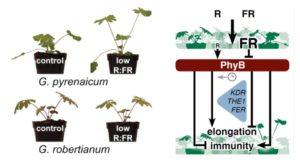 Shade avoidance syndrome (SAS) is a growth pattern in which stem and petiole elongation is stimulated in plants exposed to vegetative shade, as revealed through a low ratio of red to far-red light perceived by phytochrome; red light is absorbed by chlorophyll, leading to a far-red enrichment in light that passes through a leaf. The molecular mechanisms downstream of phytochrome have been elucidated largely in Arabidopsis. Gommers et al. set out to compare the SAS between two species of Geranium, one that grows in an open environment and the other that grows in the forest floor and does not display elongation growth in response to shade. Through a transcriptomic comparison of the two Geranium species, several differentially regulated genes were identified and then functionally demonstrated as novel regulators of SAS in Arabidopsis. The authors also showed differential phytochrome control of plant immunity genes between the two species. Plant Cell
Shade avoidance syndrome (SAS) is a growth pattern in which stem and petiole elongation is stimulated in plants exposed to vegetative shade, as revealed through a low ratio of red to far-red light perceived by phytochrome; red light is absorbed by chlorophyll, leading to a far-red enrichment in light that passes through a leaf. The molecular mechanisms downstream of phytochrome have been elucidated largely in Arabidopsis. Gommers et al. set out to compare the SAS between two species of Geranium, one that grows in an open environment and the other that grows in the forest floor and does not display elongation growth in response to shade. Through a transcriptomic comparison of the two Geranium species, several differentially regulated genes were identified and then functionally demonstrated as novel regulators of SAS in Arabidopsis. The authors also showed differential phytochrome control of plant immunity genes between the two species. Plant Cell  Zhang et al. identify the goal of high-throughput phenotyping as to “bridge the gap between genomics and phenomics”. In this Breakthrough Technology report, they used automatic phenotyping to quantify more than 100 traits across 16 developmental stages in a maize recombinant inbred line population, and identified 988 QTL (quantitative trait loci) corresponding to these traits. Several genes not previously connected to growth rate were identified. Plant Physiol.
Zhang et al. identify the goal of high-throughput phenotyping as to “bridge the gap between genomics and phenomics”. In this Breakthrough Technology report, they used automatic phenotyping to quantify more than 100 traits across 16 developmental stages in a maize recombinant inbred line population, and identified 988 QTL (quantitative trait loci) corresponding to these traits. Several genes not previously connected to growth rate were identified. Plant Physiol. 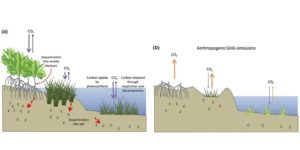 Coastal wetlands (mangroves, tidal marshes and seagrasses) are important carbon sinks, in both biomass and soils. Howard et al. describe and quantify the carbon flow through these different coastal ecosystems, and their potentials as long-term carbon sinks. Unlike the open ocean, these coastal ecosystems fall into clear national jurisdictions, so they can be more readily protected through management strategies. The authors observe that coastal wetlands, as long-term carbon sinks, should be a priority for climate mitigation efforts. Front. Ecol. Environ.
Coastal wetlands (mangroves, tidal marshes and seagrasses) are important carbon sinks, in both biomass and soils. Howard et al. describe and quantify the carbon flow through these different coastal ecosystems, and their potentials as long-term carbon sinks. Unlike the open ocean, these coastal ecosystems fall into clear national jurisdictions, so they can be more readily protected through management strategies. The authors observe that coastal wetlands, as long-term carbon sinks, should be a priority for climate mitigation efforts. Front. Ecol. Environ.  Hypoxia is a condition in which oxygen availability is insuffient to support normal cellular functions. Hypoxia is often associated with stress such as flooding, and responses to hypoxia include increased glycolytic activity and fermentation. Considine et al. review the role lf hypoxia and tissue oxygen status, as well as reactive oxygen species (ROS) and reactive nitrogen species (RNS), in normal development, including the role the N-rule pathway of proteolysis and ERFVII transcription factors in hypoxia responses. They also summarize evidence for spatial gradients in ROS and RNS and their contributions to developmental phase changes such as the maintenance of quiescence center at the root, anther development, photomorphogenesis and seed germination. Trends Plant Sci.
Hypoxia is a condition in which oxygen availability is insuffient to support normal cellular functions. Hypoxia is often associated with stress such as flooding, and responses to hypoxia include increased glycolytic activity and fermentation. Considine et al. review the role lf hypoxia and tissue oxygen status, as well as reactive oxygen species (ROS) and reactive nitrogen species (RNS), in normal development, including the role the N-rule pathway of proteolysis and ERFVII transcription factors in hypoxia responses. They also summarize evidence for spatial gradients in ROS and RNS and their contributions to developmental phase changes such as the maintenance of quiescence center at the root, anther development, photomorphogenesis and seed germination. Trends Plant Sci. 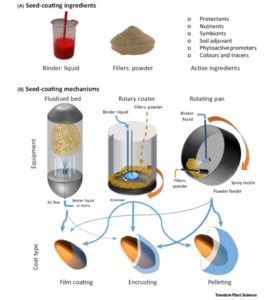 To meet the
To meet the 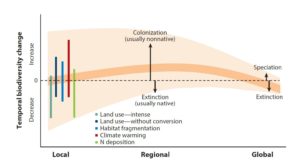 We’re living in the Anthropocene, a term that reflects the profound impact of human activities on Earth’s geology and ecology. A hallmark of the Anthropocene is a decrease in biodiversity due to an increase in the rate of extinctions. Vellend et al. examine the plant diversity has been affected during the Anthropocene. This wide-ranging review starts with an introduction to basic concepts and methods used in the study of biodiversity. The authors then summarize numerous case-studies and meta-analyses spanning local, regional, and global scales. Although they find that globally the rate of extinction has been largely offset by the creation of new species as a consequence of plant migrations, at the local level they observe widespread decreases in biodiversity due to habitat loss and fragmentation (due to urbanization and agriculture). The long-term implications for plant diversity remain highly uncertain. This is a very accessible and useful review for teaching. Annu. Rev. Plant Biol.
We’re living in the Anthropocene, a term that reflects the profound impact of human activities on Earth’s geology and ecology. A hallmark of the Anthropocene is a decrease in biodiversity due to an increase in the rate of extinctions. Vellend et al. examine the plant diversity has been affected during the Anthropocene. This wide-ranging review starts with an introduction to basic concepts and methods used in the study of biodiversity. The authors then summarize numerous case-studies and meta-analyses spanning local, regional, and global scales. Although they find that globally the rate of extinction has been largely offset by the creation of new species as a consequence of plant migrations, at the local level they observe widespread decreases in biodiversity due to habitat loss and fragmentation (due to urbanization and agriculture). The long-term implications for plant diversity remain highly uncertain. This is a very accessible and useful review for teaching. Annu. Rev. Plant Biol. 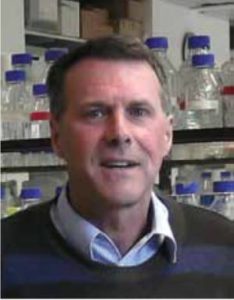 What got you interested in plant biology in general, and what influences directed you to your specific area of research?
What got you interested in plant biology in general, and what influences directed you to your specific area of research?